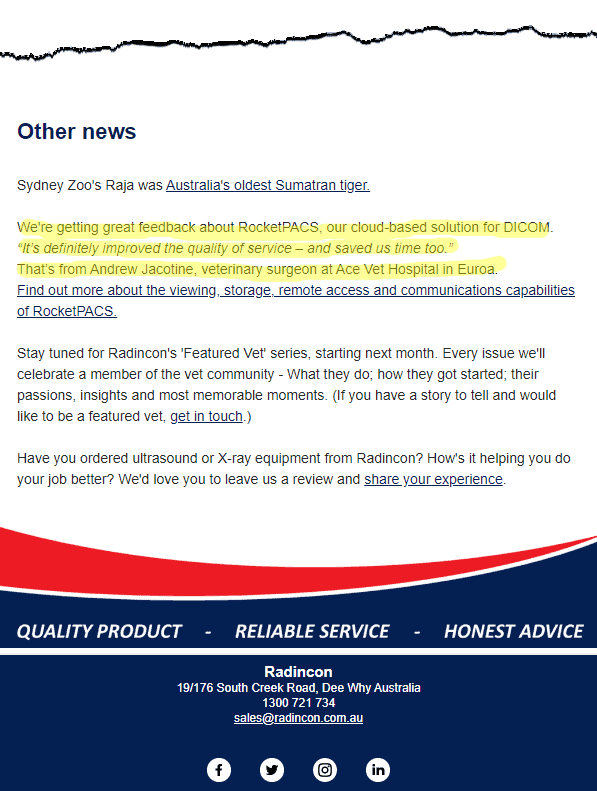We all know how important reviews and testimonials are in building brand and reputation. Most of us invest some effort into getting positive reviews posted to Google, Facebook or other sites relevant to our business. But have you ever counted up all the ways you can use testimonials yourself?
Here are some ideas based on our experience at NoBull Marketing, with both our own testimonials and those we’ve seen from clients.
1. Say thank you
It’s a really obvious way to start, but remember to say thank you to the person who gave you the testimonial.
If it’s on Google or Facebook, leave a reply. Not only does this make your client feel good, it shows everyone else looking at your profile that you are responsive and polite.
But you don’t have to stop there. You can also call or email them yourself to say thanks. This is great for relationships. It also goes a long way towards getting their support with some of the other ideas below.

2. Ask your client to spread the word
People often post reviews to their favourite site, or alternatively they may just send thanks to you individually. A simple way to get more out of that positive feeling is to ask them to post elsewhere.
If you’re emailing them to say thank you anyway, include links to your Google MyBusiness, Facebook page or any industry sites you’d also like them to consider posting to.
3. Ask permission to use the testimonial
At the same time, ask them if they’re happy for you to use their testimonial in your marketing.
Many will simply say yes. Some may come back and ask how you’re planning to use it, especially if you’re working with businesses rather than consumers, or in a sensitive area such as health or divorce and separation. Sometimes people and businesses aren’t happy with a testimonial posted publicly, but may be willing to let you include it in proposals, which by their very nature go to far fewer people.
4. Share on your social media
Reviews and testimonials make great social media posts! Remember to tag your client and thank them again for the positive feedback. If they’re a business, it’s more exposure for them too.
You could also consider a pinned testimonial post at the top of your feed, to get maximum impact for casual visitors. You can change the testimonial every so often, as well.

5. Use testimonials all over your website
It’s great to have a testimonials page.
It’s better to have testimonials on the pages most people visit, or where serious prospects end up. Your home page and your service pages, for example. Some businesses (like our client DemoPro) use a slider to make sure their positive reviews appear on every page.
It’s best of all to have directly relevant testimonials on each and every service page. Check out the testimonials for Australian Mega Colours. It’s clear that commercial and residential painting clients have different priorities, so a testimonial which relates to that specific service is ideal.
6. Add testimonials to your newsletter
Keep reminding existing clients and prospects how wonderful you are! They won’t all be rushing back to your website to check for new reviews, and even if you post on social media, they slip down the feed fast. But adding them to an email newsletter will give a little extra warm feeling.

7. Use testimonials in ads and on landing pages
If you’re running ads to promote a particular product or service, include directly related reviews in the ad or on the landing page. Note that people are very cynical about reviews and testimonials on pages which ‘hard sell’. Here more than anywhere, try to include full details of who the testimonial’s from. That could mean the name, the job title, the company, the suburb, even a photo. Or perhaps consider a video testimonial?
8. Extend a testimonial to create a case study
What’s the main difference between a testimonial and a case study? The level of detail. Case studies (good case studies, anyway) also tend to have a story which presents a situation, issue or challenge, then explains how you fixed that. The best have concrete, measurable results.
Case studies are great when you have fantastic results, a clear story or a well-known customer. The best have all three!
Use case studies as a downloadable, shareable piece of content. Make them into blog posts. Add them to proposals and tenders.
With reviews, the more the merrier. With case studies, there’s more work involved. You often have to go back to the client and get some more detail. So pick the right clients to work with.
9. Consider advertorials or sponsored content
The old newspaper and magazine concept of the advertorial hasn’t gone away with the arrival of digital. Online, it’s called ‘sponsored content’ or ‘native advertising’ – but the main idea is the same. Everyone expects you to say how good you are, but when your clients say how good you are, that’s far more persuasive!
For this kind of promotion, you need strong relationships with happy clients. One factor to mention to your client is that it’s good promotion for them as well as you!
10. Include in presentations and proposals
Let’s finish with something obvious. Use testimonials and reviews in your main sales presentations and proposals.
Very often there’s a page at the end of a sales Powerpoint which has lots of client logos. Try adding one or two client testimonials – if possible chosen to match your prospect. You’re at the pointy end of the sales process by the stage you’re presenting, so provide as much credibility as you can. That means a name, position in the business, photo, so the review almost acts as a reference too.
How many of these 10 ways to use testimonials have you tried? Which work best for you?
It can be hard to keep on top of little marketing opportunities like these, but they can also make all the difference. If you’d like some help, let’s talk!





